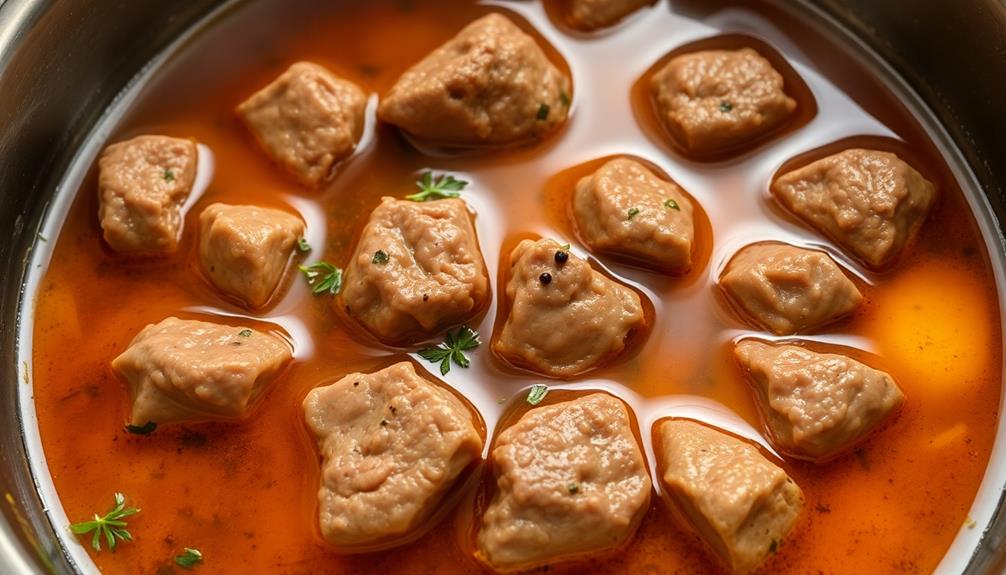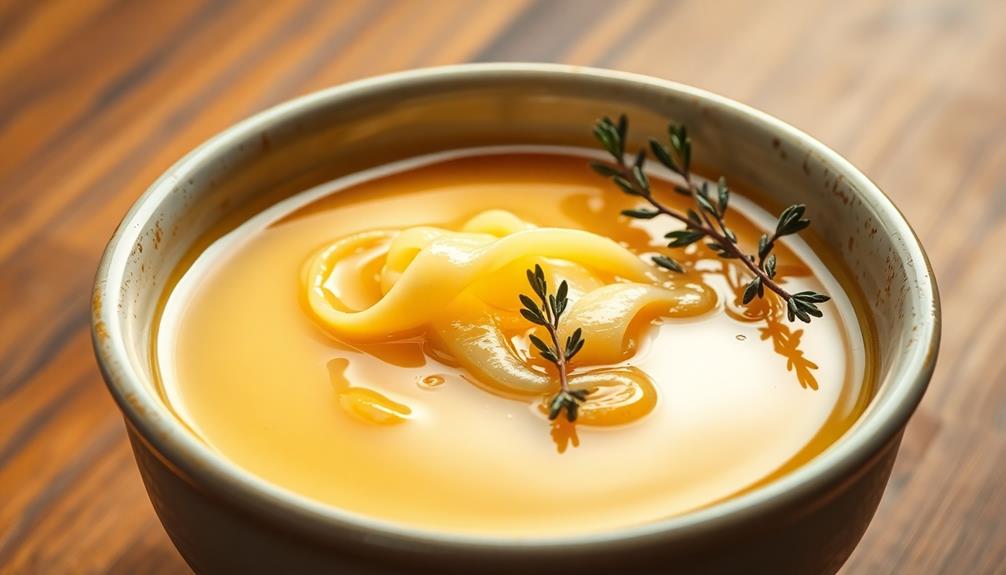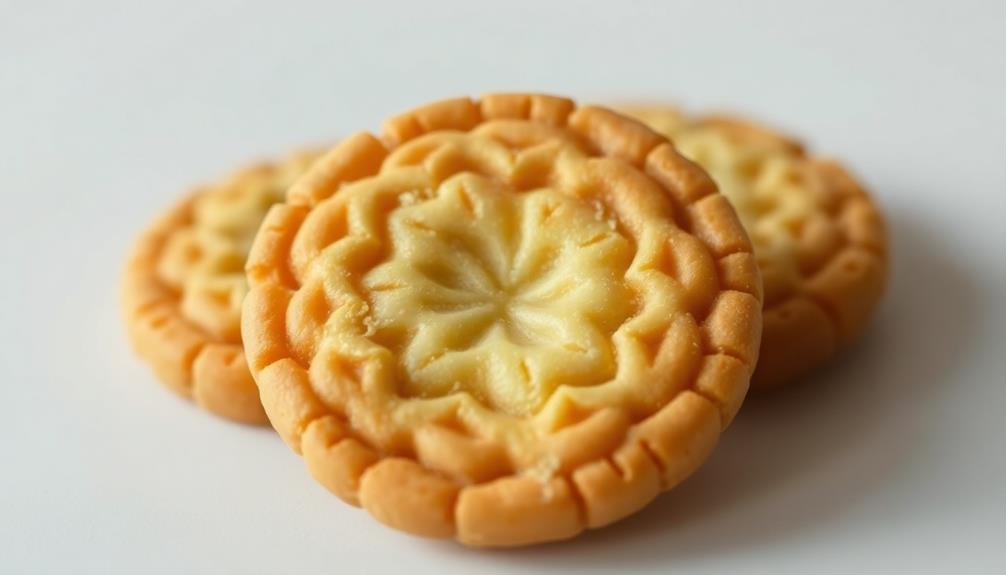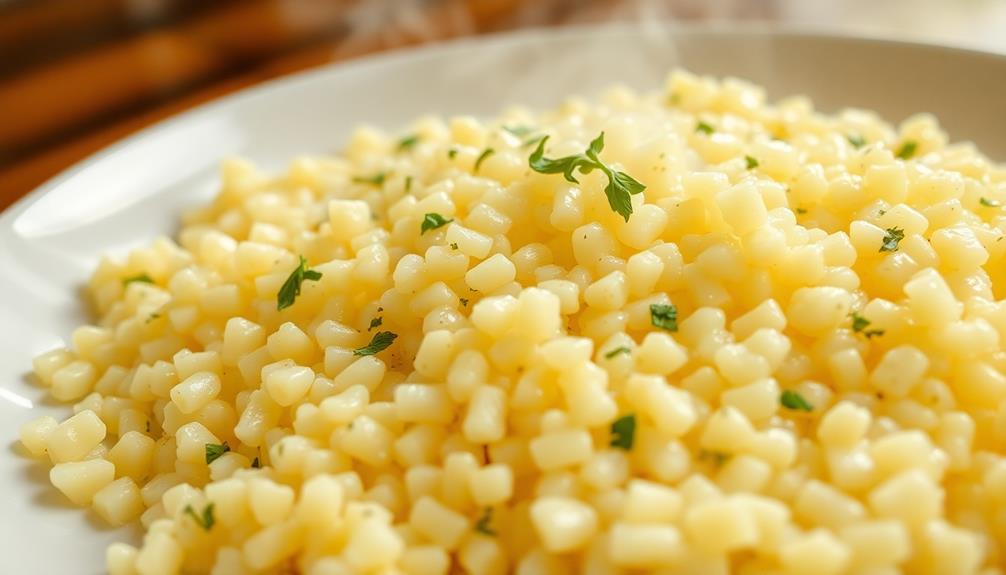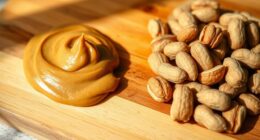Cozy up on a chilly night with the rich, comforting flavors of classic Russian butter-braised beef. This beloved dish features tender chunks of beef slow-cooked in a velvety butter sauce, infused with aromatic herbs and spices. The long, gentle braising transforms tough cuts into melt-in-your-mouth morsels that'll warm your soul. Enjoy this flavorful masterpiece over creamy mashed potatoes or buttery egg noodles for a hearty, satisfying meal. Whether you're impressing guests or treating yourself, this Russian treasure is a must-try culinary classic that'll have you coming back for more. Let's dive deeper into the history and cooking secrets that make this dish truly unforgettable.
Key Takeaways
- Russian butter-braised beef is a classic dish that showcases slow-cooked beef in a velvety butter sauce, originating from the culinary heritage of Imperial Russia.
- The tender beef is enhanced by aromatic spices, onions, and garlic, creating a melt-in-your-mouth delicacy that is perfect for warming the soul on cold nights.
- The long, gentle braising process transforms tough cuts of beef into succulent morsels, making this dish a prized comfort food among Russian nobility and families alike.
- Serving the butter-braised beef over creamy mashed potatoes or buttered egg noodles complements the rich flavors and creates a complete, satisfying meal.
- The dish's inviting aroma, tender texture, and combination of buttery richness make it an impressive and indulgent addition to any recipe repertoire.
History
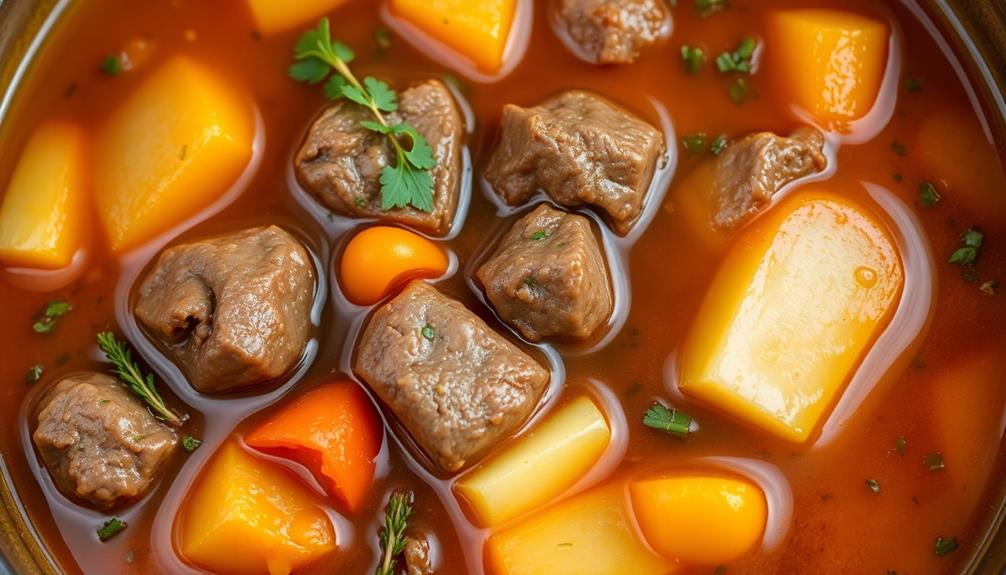
The origins of butter-braised beef can be traced back to the rich culinary heritage of Imperial Russia. During the 18th and 19th centuries, the Russian nobility prized this dish for its tender texture and deep, savory flavors.
Wealthy landowners would slowly braise thick cuts of beef in an abundance of creamy butter, allowing the meat to become meltingly soft and infused with the rich, nutty notes of the dairy.
This traditional preparation was a luxurious affair, reserved for grand feasts and celebrations in the opulent palaces of the Tsars. The slow cooking process tenderized even the toughest cuts, transforming them into succulent, flavor-packed morsels.
As the beef simmered, the butter would caramelize, lending a golden hue and irresistible sweetness to the dish.
Over time, butter-braised beef became a beloved comfort food, cherished for its ability to warm the soul on cold Russian nights.
Today, this time-honored recipe remains a treasured part of the country's culinary legacy, a delicious link to its storied past.
Recipe
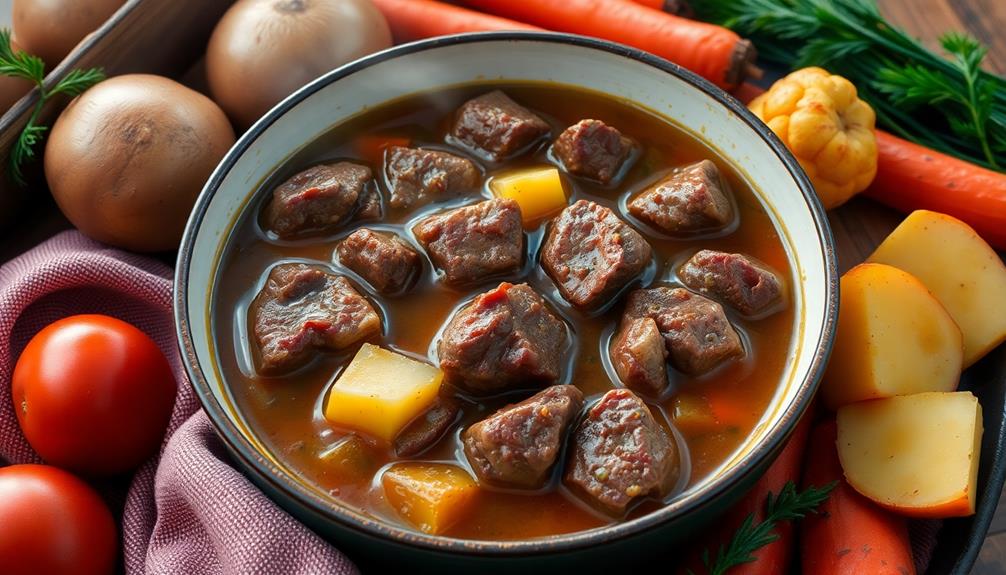
Russian Butter-Braised Beef is a classic dish that showcases the rich, comforting flavors of slow-cooked beef in a velvety butter sauce. This recipe is a perfect blend of tender meat, aromatic spices, and the indulgence of butter, creating a truly satisfying and authentic Russian culinary experience.
The key to this dish is the long, gentle braising process that transforms the beef into a melt-in-your-mouth delicacy. The mixture of onions, garlic, and aromatic herbs infuses the meat with a depth of flavor that's further enhanced by the luxurious butter sauce.
Ingredients:
- 2 lbs beef chuck roast, cut into 2-inch cubes
- 1/4 cup unsalted butter
- 1 large onion, diced
- 4 cloves garlic, minced
- 2 bay leaves
- 1 tsp dried thyme
- 1 tsp smoked paprika
- 1 cup beef broth
- 1/2 cup dry red wine
- Salt and freshly ground black pepper to taste
Cooking Instructions:
In a large Dutch oven or heavy-bottomed pot, melt the butter over medium-high heat. Add the beef cubes and brown them on all sides, about 3-4 minutes per side.
Remove the beef from the pot and set aside. Reduce the heat to medium, add the onions, and sauté until translucent, about 5-7 minutes. Add the garlic and cook for an additional minute, until fragrant.
Return the beef to the pot, along with the bay leaves, thyme, smoked paprika, beef broth, and red wine. Bring the mixture to a boil, then reduce the heat to low, cover, and simmer for 2-3 hours, or until the beef is fork-tender.
Tips:
For best results, use a high-quality, well-marbled beef chuck roast. The long braising time will tenderize the meat and allow the flavors to develop fully.
Be sure to season the beef generously with salt and pepper before browning to enhance the overall taste. Serve the Russian Butter-Braised Beef over creamy mashed potatoes or buttered egg noodles to soak up the delicious sauce.
Cooking Steps
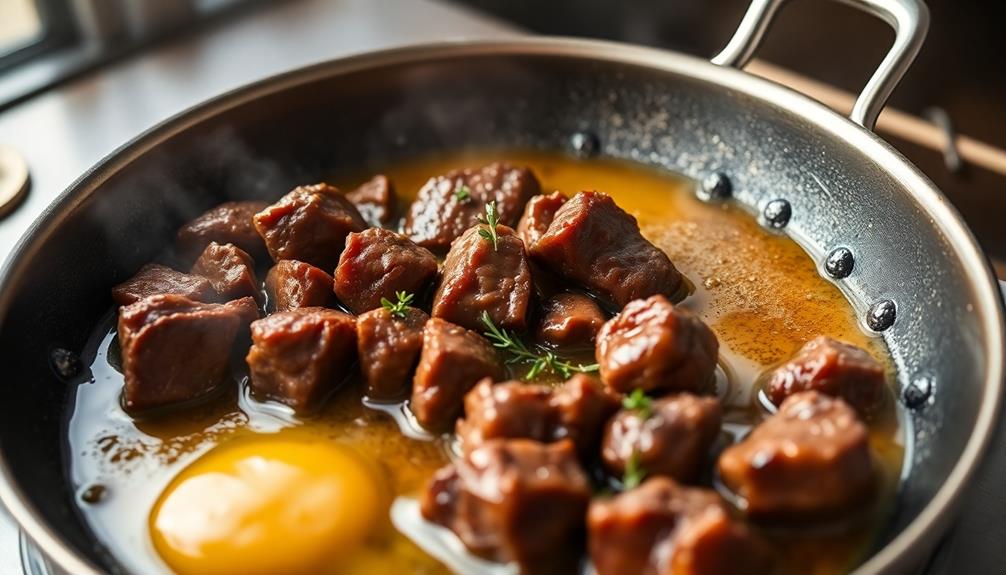
Start by seasoning the beef with salt and pepper.
Sear the meat in a hot pan until it's nicely browned on all sides.
Next, toss in some aromatic veggies like onions and garlic, then let the whole thing braise until the beef is meltingly tender.
Step 1. Season the Beef

First, season the beef generously with salt and pepper. You want to make sure every inch of the meat is coated, as this is the foundation for the dish's amazing flavor.
Rub the salt and pepper into the beef with your fingers, getting into all the nooks and crannies. The salt will help tenderize the meat, while the pepper adds a warm, spicy kick that complements the richness of the beef and butter. This step is crucial, as butter enhances the flavor of savory dishes, making the seasoning even more impactful butter enhances flavor.
Next, let the seasoned beef sit at room temperature for about 30 minutes. This allows the seasoning to really penetrate the meat, ensuring every bite is bursting with taste.
You can even give it a little massage to work the salt and pepper in even further. When the time's up, the beef will be ready to sear to perfection, locking in those delicious juices.
Get ready for the kitchen to fill with mouthwatering aromas as the beef browns to a beautiful caramelized crust.
Step 2. Sear the Beef Until Browned
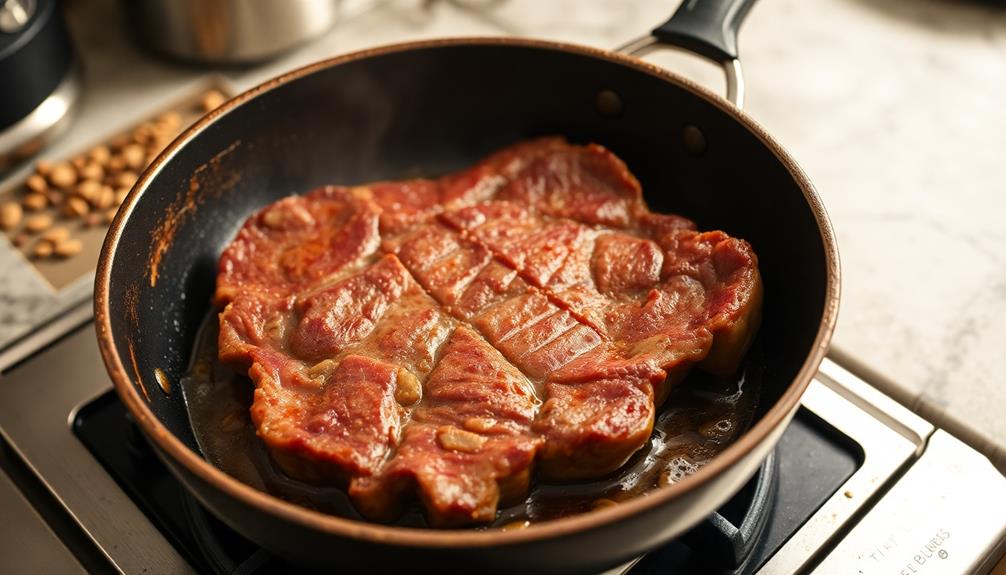
The pan's sizzle signals the start of the beef's transformation. Place the seasoned beef into the hot pan and let it sear, allowing the natural sugars to caramelize.
Don't be tempted to move the meat just yet – give it time to develop that gorgeous, golden-brown crust. As the beef cooks, the aroma will fill your kitchen, making your mouth water in anticipation.
Using tongs, carefully flip the beef to sear the other side. Listen for that satisfying sizzle as the meat hits the hot pan. The key is to resist the urge to overcrowd the pan – work in batches if needed to ensure each piece has enough space to brown properly.
Once the beef is evenly seared on all sides, transfer it to a plate. The beef will continue to cook as you prepare the next steps, so don't worry if it's not fully cooked through.
Next, you'll add the aromatic vegetables to the pan, building layer upon layer of rich, comforting flavor.
Step 3. Add Aromatics and Braise
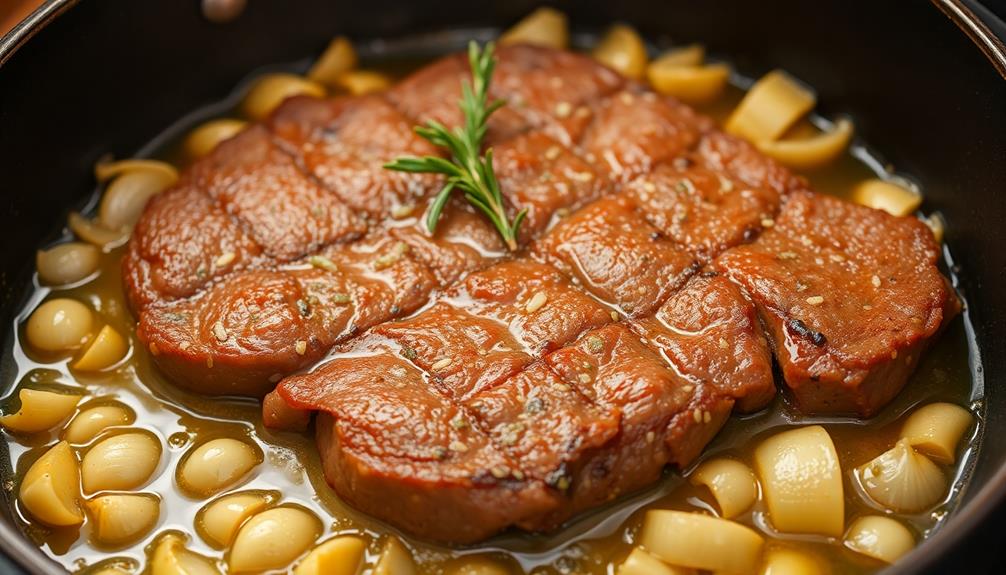
In the same pan, sauté the aromatic vegetables until they're lightly browned and fragrant. The rich, earthy aroma of onions, garlic, and thyme will fill your kitchen, setting the stage for the next step of this captivating culinary journey.
As you enjoy the delightful scents wafting through your home, consider that certain aromas can enhance your mood and create a calming atmosphere, similar to the effects of aromatherapy for emotional well-being.
Slowly pour in the beef broth, scraping up any flavorful bits stuck to the bottom of the pan. This liquid gold will form the foundation of your braising liquid, infusing the meat with deep, complex flavors.
Next, nestle the seared beef back into the pan, ensuring it's surrounded by the aromatic vegetables and broth. Cover the pan with a tight-fitting lid and transfer it to the oven.
As the beef simmers away, the connective tissues will gradually break down, transforming the once-tough cut into a meltingly tender masterpiece. Baste the meat occasionally, allowing the flavors to mingle and the sauce to thicken to a velvety consistency.
Get ready to experience the ultimate in comfort food bliss!
Step 4. Add Vegetables

To the pan with the seared beef, add the carrots, potatoes, and celery. The vibrant colors of these fresh veggies will bring a delightful contrast to the rich, golden-brown meat. Gently drop them in, arranging them around the beef so they'll soak up all those incredible flavors.
For an even more wholesome meal, consider the health benefits of clean homes, as a tidy kitchen can inspire more enjoyable cooking experiences.
Now, pour in the beef broth, just enough to reach about halfway up the sides of the meat. This will create a cozy, steamy environment for the vegetables to simmer and tenderize. As the broth bubbles and the aroma fills the kitchen, you'll know you're one step closer to a soul-warming meal.
Don't forget to season with a pinch of salt and pepper – these simple seasonings will enhance the natural sweetness of the produce.
Cover the pan and let the ingredients meld together, allowing the vegetables to become fork-tender and the beef to grow even more succulent. Soon, you'll be ready to serve up a comforting, homemade dish that's sure to delight.
Step 5. Finish Braising Until Beef Is Tender

Once the vegetables have simmered in the broth for a bit, it's time to let the beef finish braising until it's fall-apart tender. Cover the pot and reduce the heat to low, allowing the beef to slowly tenderize over the next 1-2 hours. The rich, buttery sauce will continue to infuse the meat with its mouthwatering aroma and flavor.
As the beef braises, the connective tissues will break down, making the meat incredibly tender and easy to shred with a fork. Periodically check on the pot, giving the contents a gentle stir to ensure even cooking.
You'll know the beef is ready when it practically falls apart at the lightest touch. The texture should be soft, yielding, and perfectly cooked through.
Once the beef is fork-tender, remove the pot from heat. Taste the sauce and adjust seasoning as needed, adding a pinch more salt and pepper if desired.
Serve the Russian butter-braised beef immediately, spooning the velvety sauce over the top. Get ready to savor the ultimate comfort food on a cold night!
Final Thoughts
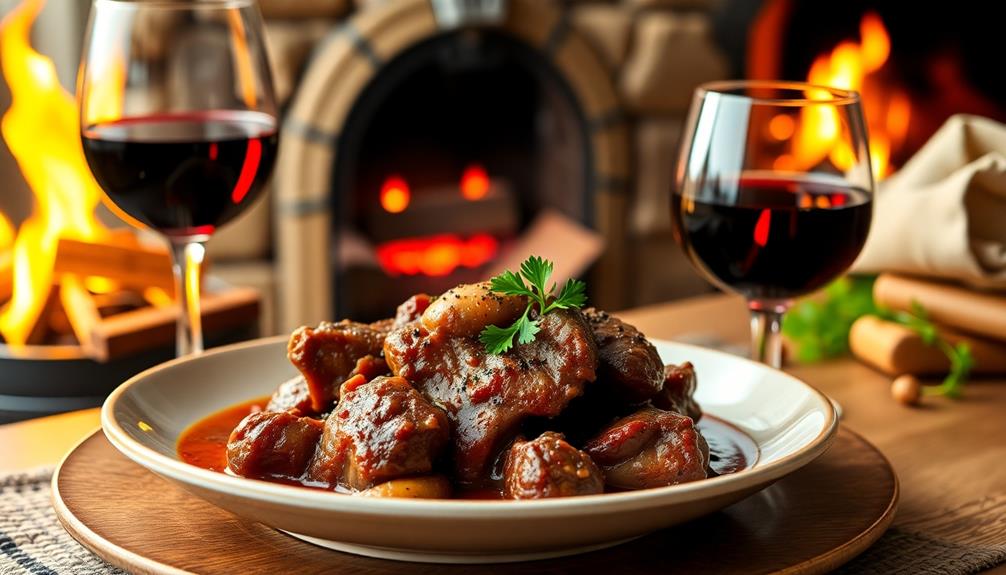
This butter-braised beef dish is a true delight, embodying the rich flavors and comforting essence of Russian cuisine. The tender, fall-apart meat simmered in a heavenly mixture of butter, broth, and aromatic herbs is sure to warm your soul on even the chilliest of nights.
The inviting aroma that fills your kitchen as it cooks will have your family eagerly awaiting the meal. Once you've savored the first bite, you'll understand why this dish is a beloved classic.
The combination of buttery richness and melt-in-your-mouth texture is simply irresistible. Serve it over fluffy mashed potatoes or buttered egg noodles to soak up every last drop of the luxurious sauce.
This is a recipe you'll want to keep in your arsenal, as it's sure to impress guests and become a new family favorite. So, grab a spoon and prepare to indulge in the comforting deliciousness of this Russian butter-braised beef.
[DIRECTIONS]:Frequently Asked Questions
Is Russian Butter-Braised Beef a Traditional Russian Dish?
Yes, Russian butter-braised beef is a traditional Russian dish. It's a comforting and hearty dish that's been enjoyed for generations, perfect for warming up on chilly nights. The slow cooking process tenderizes the beef and infuses it with rich, buttery flavors.
What Type of Beef Is Best for This Recipe?
For the best results, you'll want to use a tougher, less expensive cut of beef like chuck or brisket. These cuts become incredibly tender when braised in butter and flavorful seasonings.
Can I Make This Dish in a Slow Cooker?
Yes, you can make this dish in a slow cooker. The slow cooking process will tenderize the beef and infuse it with the rich, buttery flavors. Just be sure to adjust the cooking time accordingly.
How Long Does the Beef Need to Braise?
To get the beef tender and flavorful, you'll need to braise it for 2-3 hours in the slow cooker. The longer you cook it, the more tender the meat will become, so adjust the time to your liking.
Can I Freeze Leftover Russian Butter-Braised Beef?
Yes, you can definitely freeze any leftover Russian butter-braised beef. Simply let it cool completely, then transfer it to an airtight container or freezer-safe bag and freeze for up to 3 months. When ready to enjoy, thaw it in the refrigerator overnight.
